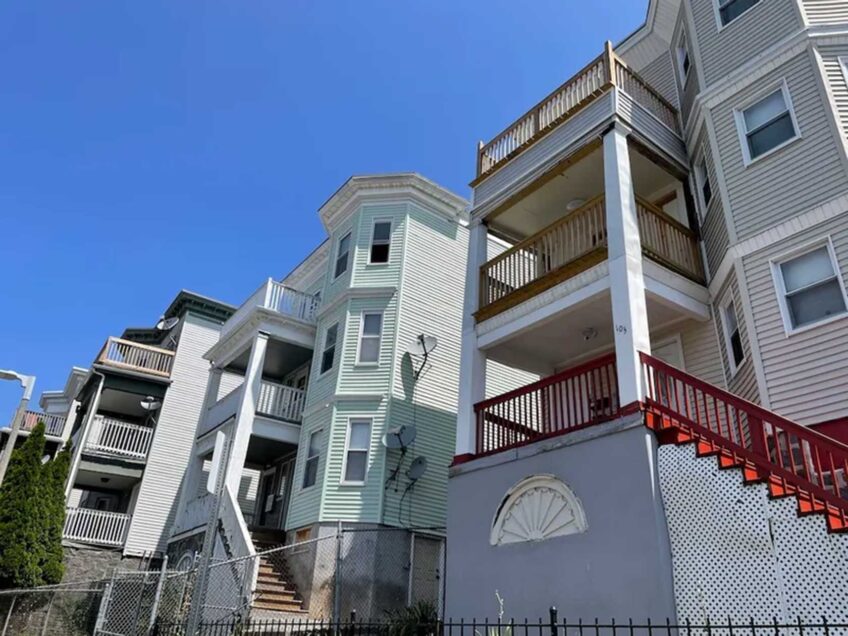City seeks developer for Chinatown parcel
RFP calls for 50% affordability, 20,000 sq-ft community space
A parcel of vacant, publicly owned land in Chinatown leaves local community organizers hopeful for what they say is much needed housing and community space.
Parcel R-1, which falls between Tyler Street and Hudson Street, was long used as a parking lot by Tufts University, which held the development rights to the parcel since the mid-1990s. In 2017, after community organizers pushed for development on the land and Tufts’ five-year lease was set to expire, the university agreed that it would give up development rights in exchange for a year-by-year lease.
Now, a request for proposals (RFP) released in June by the Boston Planning and Development Agency (BPDA) guides potential developers to consider building affordable housing — with both rental and ownership opportunities — and community space on the approximately 18,714-square-foot parcel.
For local organizers, the possibility of new affordable housing in the neighborhood is welcome news.
“There’s very little public land in Chinatown, and this is one the few undeveloped parcels of public land remaining,” said Lydia Lowe, director of the Chinatown Land Trust. “Since Chinatown real estate is so expensive, public land presents the biggest opportunity to get a lot of affordable housing into the community.”
In the RFP, the BPDA said at least 50% of the units must be income-restricted. The document said that developers should aim to keep affordable rental units between 30% to 60% of the area median income (AMI) and affordable home ownership units should be between 60% and 100% AMI.
Lowe said urban renewal in the middle of the 20th century, as well as a more recent boom in luxury high-rises, have led to displacement of residents.
“What has kept Chinatown in place is the fact that we do have a lot of subsidized housing, some of which was built as replacement housing because so many homes were destroyed during urban renewal,” Lowe said. “But we really feel like, with so much luxury housing coming in, it’s caused the eviction of most of its residents from the privately owned, unsubsidized housing.”
Angie Liou, executive director of the Asian Community Development Center, said the COVID-19 pandemic has made the situation more difficult for residents.
“The pandemic made things a lot worse, in terms of the housing crisis,” Liou said. “The majority of residents living in Chinatown work in industries that were heavily impacted by the pandemic, like food service, restaurant workers, home healthcare aids, hotel workers.
The proposed community space also presents exciting possibilities, local organizers said. They hope that it might serve as a permanent branch of the Boston Public Library (BPL). Chinatown’s last permanent branch was demolished in the 1950s to make way for housing and highways. Until a temporary space was opened in 2018 in the basement of the China Trade Center, the neighborhood had no physical public library space to call its own.
Liou called the lack of a public library branch an equity issue and said that a library would serve as an important gathering spot for community members.
“There are just not a lot of civic spaces where retired elderly or young people or children can go read Chinese language papers or to get help with homework, spend a few quiet hours reading or access the computer,” Liou said. “What we see is sometimes the elderly, they might go to a place like Dunkin’ Donuts, but again, that’s not the same and cannot replace a civic space like a neighborhood library.”
Her biggest complaint about the temporary branch is that it’s too small. A permanent location would help solve that issue.
While the RFP doesn’t require plans to include a library, it does specify that plans must include up to 20,000 square feet of community space on the first and second floors and describes the parcel as a location that the BPDA, the City of Boston, BPL and members of the community have found favorable as a location for a permanent branch.
Reay Pannesi, senior real estate development officer for the BPDA, said she can’t fully speculate on what will come out of an RFP, but is “pretty optimistic” that a plan with space for a public library is likely to come out of the process.
If a library is included in the plans, the developer would be responsible for building 15,000 to 20,000 square feet of space on the first and second floors. BPL would then fit it out for library use, at its own expense, after acquiring the space.
Community oversight sought
Another concern for community members is having oversight over the project through its completion and beyond. Lowe said it was a big step when, as a community, they could convince Tufts to give up development rights to the land. They want to continue to have an impact on the project as it progresses.
Pannesi said there is community engagement built into the process of selecting a proposal and moving forward with it. She said the BPDA will bring proposals that meet their standards in front of the community for feedback. After one is selected and goes to the BPDA Board for tentative approval, the following process continues to include support and oversight from a group of community members.
In terms of lasting oversight for the housing that will be included on Parcel R-1, in its brief to developers, the BPDA said that the community has “expressed a strong interest” in using measures like community land trusts to preserve housing affordability for longer. It also says, “The community has also articulated an interest in seeing proposals that include a governance role for community entities in the operations of the housing that is developed.”
While this indicates to developers that including some system for community governance might earn them a few points with their proposal, it includes no imperative to work one into the plan. Pannesi said they tend to opt for development objectives and guidelines in RFPs over highly prescriptive rules in order to encourage creativity and stay open to more proposals.
“We tend not to dictate what we want to see, but we put it out there and say, ‘This is what the community would like to see,’ because we feel that if we dictate things, we can’t cast as broad a net,” Pannesi said. “So, we think we’re making that pretty clear that the community has sort of articulated [a desire for oversight]. … It’s really up to the development teams to create some kind of a model. We’re trying to call on the team’s creativity and innovation, rather than say, ‘We want to see it this way.’”
According to the RFP, a portion of the land currently in use as a parking lot is privately owned, though developers are allowed to submit proposals that incorporate the private land as long as they can show that they have worked to acquire the land. Lowe said she thinks including the private land would help make “a really good project.”
Proposals for the development are due to the BPDA by Oct. 28, which they will then review and bring to the public for discussion. Pannesi said she expects a proposal to go to the BPDA Board for tentative approval by December 2021 or January 2022 at the earliest.





